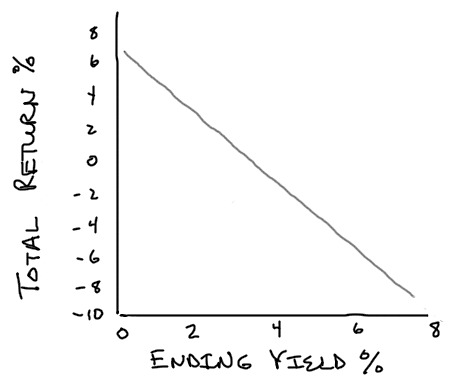
- Monday, August 29th, 2011
- bond math
-
In our look at the geography of investment style,the research puzzle | Here’s the previous posting, which opened the series. there are elements to consider that fit into those classifications that are commonly used within the business and then there are factors that are pervasive in nature. This posting concerns an example of the latter.
At its most basic level, bond math is straightforward, showing what return will come your way under a set of assumptions. Take the current U.S. Treasury ten-year note and look at the total return that it can produce over the next three years, based upon the ending yield:

Let’s say you’d like to get returns like those of the last twenty-five years on similar bonds, namely in the neighborhood of 7.5% per year. Good luck. Even if yields fall to 0.1%, you’ll get an annual return of less than 6.5% for those three years. By the way, do you think they’ll fall to 0.1%?
This, of course, is an uncomfortable fact for corporate, union, and public pension plans, not to mention individuals looking at projections from their investment advisors and financial planners. Many have not lowered their expectations to reasonable levels given their default asset allocations and the relentless reality of bond math when market rates are low.
So, a key consideration when evaluating investment managers or their strategies is the likelihood of success in a given market environment. Sure, ten-year rates can go to 0.1%, but I dare say it’s not a good bet. Similarly, when equities as a class are trading at valuations significantly higher than normal, they can go higher still, but based upon historical precedent and economic forces over any reasonable time horizon they tend to deliver returns below historical averages.
Given the market structure in place, does the strategy under review make sense and is it being implemented by the investment manager in a way that doesn’t expose you to a set of risks that is different than you might expect?
In a time of low rates, is a manager venturing further out the yield curve or down in quality or into unfamiliar vehicles to try to deliver returns? At what point do you question the strategy and adjust your expectations, or do you just hope for the best?
Looking at it a different way, no matter the asset class, if the prospect of producing attractive returns is getting more unlikely, do you really expect the manager to call you up and say that you should consider withdrawing money? That would mean no management fee for the manager, so it rarely happens. Instead, there is a drifting along with the market waves, even when an abrupt change of course would be better.
Of course, benchmarks drift as well. All else being equal, the duration of a bond index goes up as rates drop and the valuation of a stock index goes up as prices climb. If you are using a benchmark as your guide, you are playing a relative game (and may lose situational awarenessthe research puzzle | That was the title of a previous posting on issues related to such relativity.).
While the title of this piece is “bond math,” I use the phrase to represent a concept that applies more broadly: The natural constraints of an investment style or strategy can be too easily ignored. Your due diligence processes should involve looking for and thinking about those constraints at every turn and your selection of managers should be limited to those that admit that they exist.
Almost by definition, that excludes many who have had eye-popping performance for a time and have attracted attention and assets as a result. Seeing constraints didn’t get them to the top of the charts and they aren’t likely to change their ways. Avoiding such managers is a key to investment success.
